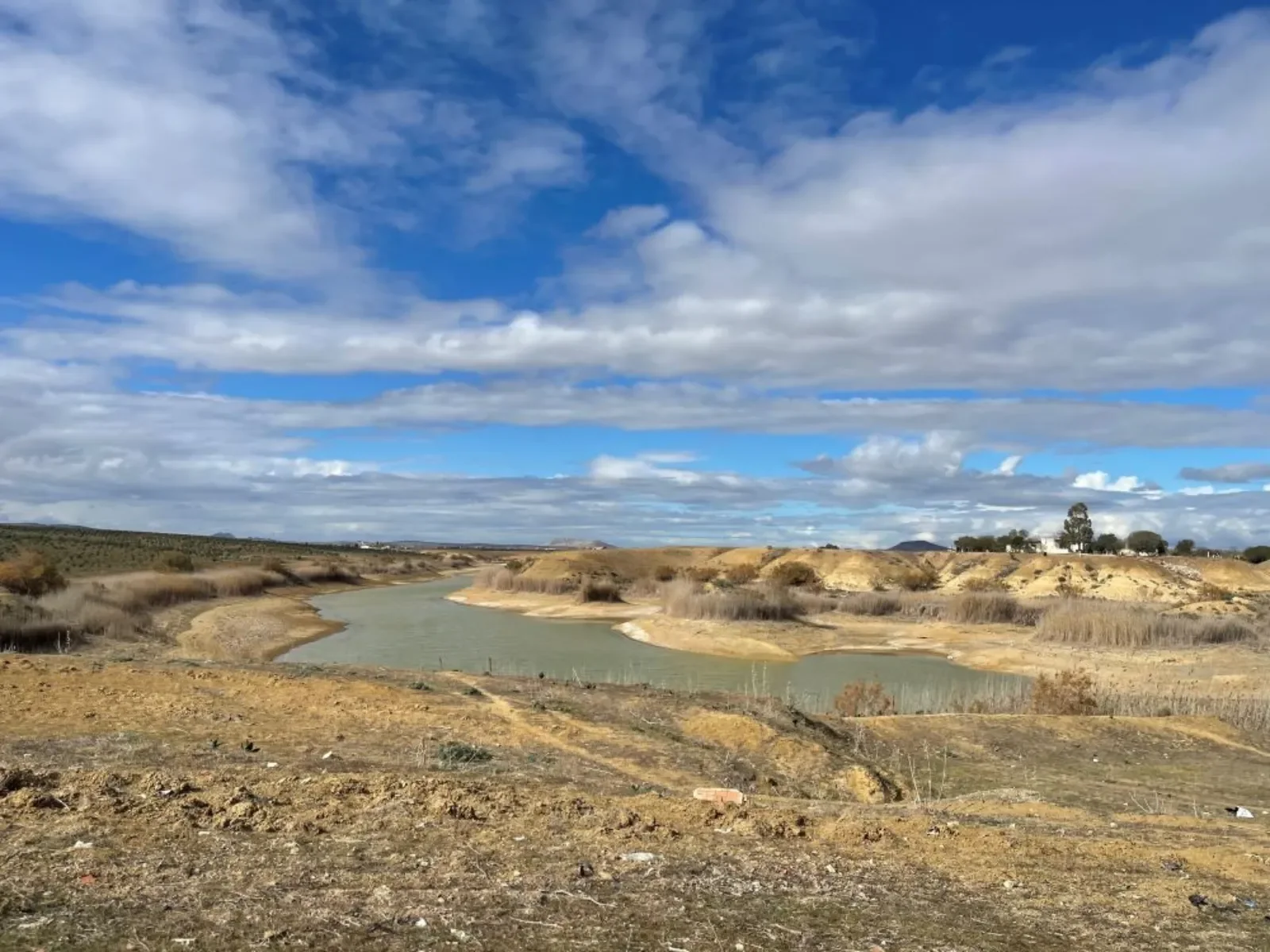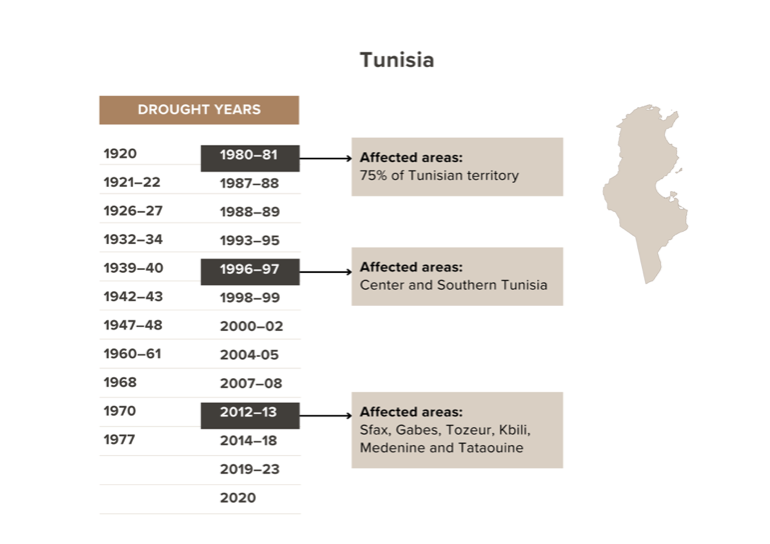Blooming in the Dry: How Smart Irrigation is Transforming Tunisia’s Agriculture
A water-depleted dam is seen near a farm northeastern Tunisia, January 30, 2023.
Introduction
Every drop of water matters in Tunisia. The nation, which was formerly renowned for its lush fields and flourishing olive groves, is currently dealing with one of North Africa's worst water crises. Farmers are finding it difficult to keep their crops alive due to rising temperatures, protracted droughts, and depleting groundwater supplies. Traditional irrigation techniques are no longer able to satisfy the needs of a drying area as climate change continues to tighten its hold.
In the face of this pressure, farmers are giving up water-wasting traditional irrigation techniques. Instead, they're adopting smart irrigation technology, including such as drip systems, soil-moisture sensors, AI-powered drones, and data platforms. According to early studies, farms that utilize smart irrigation have increased yields by 15–25% while reducing water use by up to 30%, exhibiting both economic and environmental benefits. In dry areas like Tunisia, these innovations are transforming agricultural practices, boosting climate resilience, and decreasing rural poverty. In dry regions like Tunisia, these innovations are changing the way agriculture is practiced.
The Water Crisis in Tunisia
With climate change making matters worse, Tunisia's water situation has reached a critical point. Significantly erratic rainfall is a feature of the nation's primarily arid and semi-arid environment — long-term averages indicate only about 207 mm per year, with annual evapotranspiration ranging from roughly 1,200 mm in the north to over 1,800 mm in the south. Around 75–80% of all water withdrawals are still used for agriculture, making it the largest user of water. This highlights the sector's significance as well as its inefficiencies. Renewable water resources per capita, on the other hand, are incredibly low, at about 390 m³ per person annually (2020), much below the typical standards of "absolute scarcity.” Smallholder farmers are most affected by these circumstances. They deal with declining returns, mounting expenses, and increasing income instability if they lack access to investment finance or contemporary irrigation infrastructure. As a result, in addition to endangering crop yield, a shortage of water also increases rural poverty and hastens the movement of people from agricultural to urban areas. This increasing pressure serves as a reminder that the need for more creative and effective irrigation systems is urgent rather than optional.
Smart Farming Solutions Emerging in Tunisia
Tunisian farmers and authorities are increasingly using smart farming technologies to increase resilience and efficiency in the face of growing water constraint. Drip irrigation, which avoids flooding fields by delivering water straight to the plant's root zone, is one of the most used techniques. The state's dedication to implementing such technology is demonstrated by initiatives such as Tunisia's €49 million financing package to modernize irrigation in southern oasis, which includes new infrastructure and more effective delivery systems.
Solar-powered irrigation systems are gaining popularity; farmers may lower their energy expenses and carbon footprint by switching from grid-electric or diesel pumps to photovoltaic-driven ones. One noteworthy example is the installation of a 1.5 kW solar well-pump system in October 2024 on a farm in Tunisia, which uses PV-powered pumping to deliver 6 m³ of water per hour. All three strategies—smart sensors, drip delivery, and solar pumping—are combined in one integrated project, ACCISI-GEM in the Ghar El Melh region, which results in significant water and energy savings. Together, these smart-farming strategies are beginning to reshape irrigation practices in Tunisia—offering a blueprint for sustainable agriculture in arid regions.
Success Stories: Farmers Leading the Change
Profile 1:
Sensor-enabled drip systems offered by regional agritech businesses like Ezzayra have been early adopters in the province of Nabeul by smallholder farmers. "I can manage the whole farm through a mobile app… everything here can be done in one click; irrigating, fertilizing, and even detecting any water pipe leaks," said a farmer who was profiled in an article about these firms. Significant water savings and yield benefits have been reported; farmers who utilize these digital kits frequently report double-digit percentage increases in efficiency and quantifiable water use reductions.
Profile 2:
Pilot projects for solar photovoltaic pumping systems (SPIS) have been conducted throughout Tunisia, particularly in the agricultural regions in the center and northeast where solar resources are abundant. Both socioeconomic benefits (lower fuel costs, increased reliability) and groundwater management concerns are documented in the SPIS study and subsequent technical assessments. However, farm-level case studies (such as the Cap Bon/Chiba region) show that PV water pumps can sustainably deliver several cubic meters per hour while lowering energy costs and enabling irrigation in areas where grid power or diesel is expensive. After converting to solar pumps, some farmers surveyed for these research reported increased irrigation regularity and reduced running expenses.
Challenges & Barriers
Smart irrigation and sustainable farming technologies hold great promise, but a number of obstacles still stand in the way of their widespread adoption in Tunisia. The biggest obstacle is still the expensive initial setup costs. Digital sensors, drip systems, and solar pumps can cost several thousand dinars per hectare, and many smallholder farmers cannot afford the upfront costs. The people who need these advances the most cannot access them if credit or microfinance choices are not readily available. Furthermore, the efficacy of new technology is constrained by rural farmers' lack of technical expertise. Even when equipment is available, many small-scale producers hesitate or use it insufficiently because they are not familiar with digital platforms or data-based irrigation systems. Although their reach is still restricted, training initiatives from agencies such as the German Agency for International Cooperation (GIZ) and the Food and Agriculture Organization (FAO) have assisted in closing some of these gaps.
Looking Ahead: Building a Water-Smart Future
Increasing the adoption of smart irrigation technologies might transform Tunisia's agricultural landscape, promoting sustainable water use and strengthening the nation's resilience to climate change and drought. Solar-powered pumps, drip systems, and sensor-based monitoring provide a more efficient and environmentally responsible farming model that not only conserves water but also boosts crop yields and reduces energy costs. Because it ensures that farmers can effectively operate and maintain state-of-the-art technology, investing in education and training is essential to expanding these solutions. Financial tools that enable smallholder farmers to acquire technology, such as microloans, subsidies, and public-private partnerships, are equally significant. Smart irrigation programs can have a greater impact and reach when government agencies, non-governmental groups, and international organizations work together. Tunisia can transform its water problems into business possibilities if it maintains its dedication to innovation.



